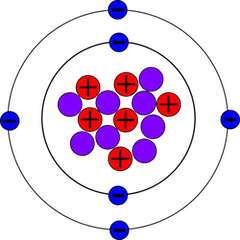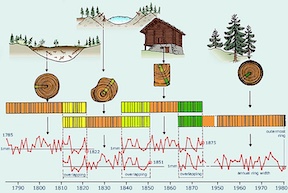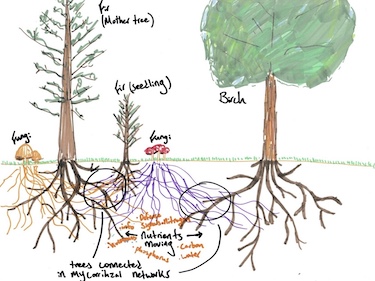Carbon-14: Difference between revisions
No edit summary |
No edit summary |
||
| Line 14: | Line 14: | ||
[[File:HowTreesTalk.jpg|376px|thumb|right|Suzanne Simard's drawing of carbon tracking through tree root systems []]] | [[File:HowTreesTalk.jpg|376px|thumb|right|Suzanne Simard's drawing of carbon tracking through tree root systems []]] | ||
==Analysis methods== | ==Analysis methods== | ||
Revision as of 15:27, 29 March 2025

Overview
Carbon-14, also referred to as 14C or radiocarbon, is one of the three naturally occurring isotopes of carbon in nature. 14C is unstable, and has a half-life of 5700 +/- 30 years [1]. The other two forms of carbon are 12C, which is what makes up 98% of all carbon in the atmosphere, and 13C, which makes up around 1% of atmospheric carbon. Both 12C and 13C are stable isotopes, while 14C is unstable. Within the context of ecology, 14C is used in two main processes: dating organic materials and tracing carbon pathways within ecosystems.
Uses

Tree Ring Dating
The suspected primary role of EPS is to create stable habitat bound to a desired substrate[1]. EPS is the matrix structure of biofilms. Biofilms are very effective at retaining water in soils even with very negative water potentials.[2] This allows microbes to resist desiccation during drought periods. EPS can also stabilize pH and reduce the amount of nutrients lost to runoff by binding to them.
Carbon-14 Tracing
EPS provides a stable interface for soil microbes to chemically work on attached substrate and suspended materials. In addition EPS can act as a store of carbon and other nutrients. The binding nature of EPS also helps reduce nutrient loss in soils from runoff.[3]

Analysis methods
Cation exchange resin (CER) extraction is currently considered the best method for accurately extracting EPS from soils.[4]This method shows the highest efficency with the least amount of modification to the original EPS composition when compared to other methods. This method works by replacing cations in the material being sampled. This destabilizes the structure and allows for separation through filtration and/or centrifuge.
References
- ↑ Cite error: Invalid
<ref>tag; no text was provided for refs namedFlemming_2016 - ↑ Cite error: Invalid
<ref>tag; no text was provided for refs namedOr_2007 - ↑ Lin, D., Ma, W., Jin, Z., Wang, Y., Huang, Q., Cai, P., 2016. Interactions of EPS with soil minerals: A combination study by ITC and CLSM. Colloids and Surfaces B: Biointerfaces 138, 10–16. https://doi.org/10.1016/j.colsurfb.2015.11.026
- ↑ Redmile-Gordon, M.A., Brookes, P.C., Evershed, R.P., Goulding, K.W.T., Hirsch, P.R., 2014. Measuring the soil-microbial interface: Extraction of extracellular polymeric substances (EPS) from soil biofilms. Soil Biology and Biochemistry 72, 163–171.